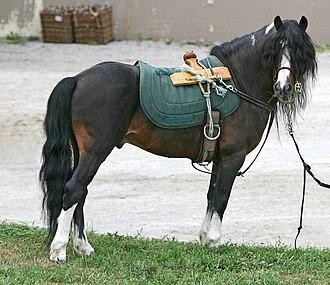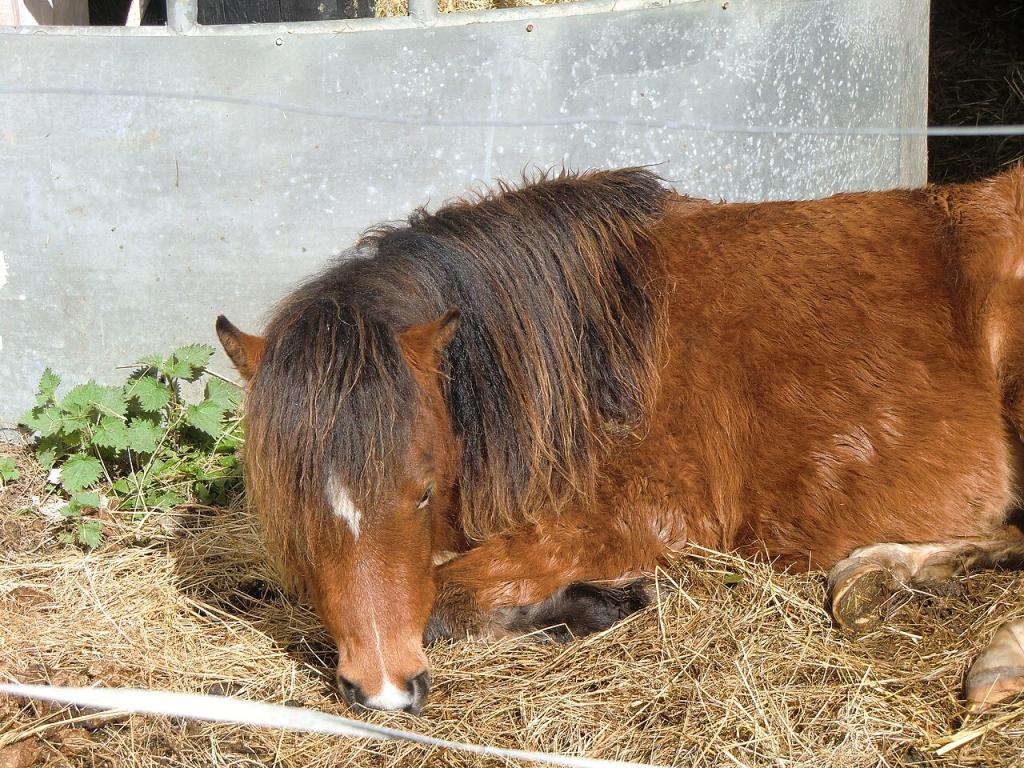
Continent:
Country: Ireland
Weight: 200 – 300 kg
Height: 102 – 117 cm

The Kerry Bog Pony is a very ancient and native Irish breed, originating specifically from the boglands and wet moors of County Kerry (southwest Ireland).
It most likely descends from small Celtic horses introduced to Ireland in antiquity, which adapted to a harsh, cold, and marshy environment. For centuries, it served as a hardy pack and light draft pony, used by peasants to transport turf, firewood, and farm products across impassable terrain.
Its small size, robustness, surefootedness, and ability to survive on poor forage made it a symbol of hardiness and survival.
Considered nearly extinct in the 20th century (fewer than 20 individuals were recorded in the 1980s), the breed was saved by dedicated breeders who undertook reconstruction and strict genetic management.
Today, the Kerry Bog Pony is recognized as a distinct breed, protected in Ireland, and conserved as a unique cultural and genetic heritage.
The Kerry Bog Pony originates from the southwest counties of Ireland, mainly County Kerry, a region marked by bogs, wet hills, and poor soils. These harsh environments shaped a hardy, frugal, and resilient pony, perfectly adapted to living freely in such landscapes.
Today, most breeding is still concentrated in County Kerry and its surroundings, where passionate breeders, grouped under the Kerry Bog Pony Cooperative Society Ltd., actively work on conservation. Small groups also exist in other parts of Ireland thanks to promotion and revival efforts.
Although the breed remains rare, some Kerry Bog Ponies have been exported to the United Kingdom, continental Europe, and North America, mainly for conservation programs. These initiatives aim to secure the breed’s survival beyond its historical homeland.
The Kerry Bog Pony is regarded as one of the oldest and rarest equine breeds in Ireland. Its preservation is of vital importance, as it represents a unique genetic heritage shaped by centuries of adaptation to the boglands and the harsh conditions of Kerry.
Through its evolution in a challenging environment, the Kerry Bog Pony has developed great resistance to bad weather, dietary frugality, and remarkable adaptability. These genetic traits make it a reservoir of hardiness, valuable for strengthening other equine populations threatened by inbreeding or lacking robustness.
The Kerry Bog Pony studbook plays a major role in conserving equine genetic diversity in Europe. Protecting this breed helps prevent the loss of rare genes, which are valuable for future breeding programs and the sustainable management of animal genetic resources.
Though small, the Kerry Bog Pony has a gentle and reliable temperament, making it suitable for light driving and as a children’s pony. Its genetic contribution could also be used in targeted crosses to reinforce docility and hardiness in other lines.
The Kerry Bog Pony traces back to small Celtic horses that arrived in Ireland over 2,000 years ago, likely of Iberian or Nordic origin brought by sea. These ponies adapted to the acidic bogs, wet moors, and poor soils of southwest Ireland. By the Middle Ages, they were already considered hardy, enduring animals, essential for local survival.
The Kerry Bog Pony became the indispensable ally of Irish peasants in marshy areas.
Main uses:
Its small size, surefootedness, and frugality made it a true survival pony, similar to the donkey’s role in other regions.
With modernized farming, mechanization, and new energy sources (coal, gas, electricity), the pony lost its role. Seen as archaic and useless, it was replaced by larger breeds (Connemara, imported ponies). By the 1970s–1980s, only a few semi-wild herds survived in the Kerry bogs, often ignored or mistaken for crossbred ponies. By the end of the century, fewer than 20 individuals remained.
In 1994, John Mulvihill, founder of the Kerry Bog Village Museum (Glenbeigh, Ring of Kerry), discovered a small surviving group in the hills and bogs of Kerry. Thanks to his initiative, the breed was recognized as Irish heritage, and a genetic preservation program was launched. DNA testing confirmed the Kerry Bog Pony is a distinct breed, different from the Connemara.
In 2002, the official studbook was opened in Ireland, ensuring structured breeding and strict genetic traceability. The Kerry Bog Pony Cooperative Society manages registrations, classifies ponies by conformity, and organizes annual shows. The breed is now listed among rare Irish breeds to be preserved.
By 2003–2004, the first ponies were exported to the United States, where the American Kerry Bog Pony Society (AKBPS) was created. Small populations now exist in North America and continental Europe (notably Austria), ensuring genetic security beyond Ireland. By 2010, the global population reached about 350–400 registered ponies.
The Kerry Bog Pony is therefore an ancient Celtic pony, adapted to the boglands of Kerry, nearly lost in the 20th century but saved in the 1990s. Today it stands as a symbol of Irish cultural heritage, protected by a studbook and represented internationally.
The Kerry Bog Pony is gentle, calm, and docile, easy to handle even by children. It shows a strong willingness to cooperate with humans, inherited from centuries alongside Kerry farmers. Highly intelligent, it learns quickly and retains knowledge, making it reliable for light driving, leisure riding, and education.
Accustomed to harsh conditions (cold, wet climates, boggy soils, poor forage), it is extremely weather-resistant. It thrives outdoors year-round with minimal feeding needs. Its endurance and agility resemble other Celtic ponies (Connemara, Eriskay).
Naturally sociable, it gets along well with other ponies and animals. Strongly attached to its environment and to humans, it often forms a deep bond of trust with its owner. Semi-wild herds in Kerry showed stable group organization and peaceful interactions.
It is highly versatile, adapting to modern uses:
It retains a strong survival instinct from its bogland adaptation:
"The Kerry Bog Pony is a small, hardy, calm, intelligent, and affectionate pony, combining endurance and gentleness. Its docile nature and great adaptability make it an ideal companion for children, leisure, and light driving, while embodying the wild and resilient spirit of Celtic ponies."
The Kerry Bog Pony narrowly escaped extinction thanks to conservation work launched in the 1990s. The priority remains to avoid inbreeding and broaden the genetic base through strict studbook management (DNA testing, inspections, conformity classes). Educational and tourist programs (such as the Kerry Bog Village and annual shows) help maintain public interest and thus the economic survival of the breed.
Though no longer a utility pony for turf transport, it finds a place as a family companion, leisure pony, light driving pony, and for educational or therapeutic work. Its small size and gentle character give it great potential for children and educational programs.
The Kerry Bog Pony is increasingly promoted as a cultural and touristic symbol of the Kerry region, playing a role in heritage tourism (Ring of Kerry, living museums, rural festivals). Thanks to exports to the United States and Austria, and the creation of the American Kerry Bog Pony Society, the breed has gained international visibility, securing its survival through populations abroad.
This is an extremely robust breed, naturally selected in harsh environments (cold bogs, acidic soils, poor vegetation). It shows strong resistance to common equine diseases and lives comfortably outdoors all year round, even in wet and cold climates.
Like many hardy ponies, the Kerry Bog Pony can live 25–30 years, sometimes more, while maintaining vitality.
Coming from an environment with limited resources, it can be sensitive to modern rich feeding (rich hay, grain). Risk of overweight and laminitis if overfed → must remain on a simple, controlled diet (poor grass, coarse hay).
No major genetic defects are known to date, unlike some reduced-population breeds. DNA testing is regularly performed to monitor genetic diversity and prevent inbreeding. The studbook enforces strict health checks for registered breeding stock.
Needs only standard veterinary care: deworming, vaccinations, and regular dental care. No predisposition to serious metabolic diseases has been recorded. The main risk remains obesity if kept on modern diets rather than its traditional bogland lifestyle (exercise + poor forage).